Thank heavens for self-seeding perennials!
I’m going to be honest: I’m all for spending a sunny day in the yard pulling weeds and puttering around in my garden. It’s one of my favorite things to do on the weekend.
A glass of wine, maybe a podcast playing on my phone, and my hammock just waiting for me in the distance when I’m done.
But when I get bogged down by my less-than-exciting daily responsibilities, I’ve been known to let my garden fall to the wayside. I know, it’s awful. But some years, those peonies just aren’t going to get divided.

We link to vendors to help you find relevant products. If you buy from one of our links, we may earn a commission.
With self-sowing perennial plants, I don’t have to do any work, and they’ll be coming back better than ever next year. My roses might be a mess, and my wisteria is reaching for my roof shingles, but darn it – my hollyhocks have never looked finer.
Many of us have had self-seeding perennials growing in our gardens before, and we just didn’t know it.
Maybe we’ve been deadheading diligently, or the birds have been making a meal out of the dropped seeds.
But if you want to plant or encourage existing plants to make an encore performance next year, this guide has you covered.
Here 29 ornamentals that will make it look like you’ve been planting hard all spring, even if you were a little less than productive:
29 Self-Seeding Ornamental Perennials
There are a couple of things to note. First, for a plant to self-seed, you must leave the flowers in place even as they fade and die off.
If you deadhead, you’ll remove the part of the plant that will turn into seeds.
If you just can’t stand it, go ahead and remove some of the heads, but leave a few behind.
You should also look for heirloom plants. If you buy a hybrid, it might be sterile, or the seeds won’t grow true, and you’ll end up with something you didn’t entirely expect.
That’s not always a bad thing, but if you really love a certain blossom, you might be disappointed when it turns out a little smaller or with a different color than you expected.
If birds are an issue – and you’ll know if you suddenly see flocks of finches and chickadees in your garden bed just as your blossoms are dropping seeds – you can take matters into your own hands by tossing a thin layer of mulch or well-rotted compost onto the soil to cover the seeds.
This might reduce how many germinate, depending on the species, but having some is better than none, right?
With that out of the way, here are some stellar options:
1. Allium
Ornamental alliums (Allium spp.) are striking. Instantly identifiable with their architectural shape and bright colors, it’s impossible to mistake them for anything else.
They’re also incredibly simple to grow and hardy all the way north to USDA Zone 3.
Whether you go for big, bold drumsticks (A. sphaerocephalon) or petite little dwarf blue alliums (A. azureum), if you leave the heads on after the flowers have faded, they’ll send out seeds and spread around without becoming aggressive in the garden.
‘In Orbit’ is a definite favorite of mine. Okay, it’s impossible to narrow it down to one favorite, but it would make it in my top 10, for sure.
It produces lavender balls that sparkle like purple fireworks from spring through fall.
Want one? Or dozens? We don’t blame you at all. Burpee carries live plants. Grab a few, and in a few years, you’ll have lots, lots more!
Learn more about growing ornamental alliums in our guide.
2. Balloon Flower
Balloon flowers (Platycodon grandiflorus) don’t need an invitation to sow themselves all over the place in Zones 3 through 8. In fact, you might need to discourage them a little.
They can become a bit aggressive when left to their own devices.
Deadhead some of the plants so that there are fewer seeds to spread themselves about. Otherwise, expect them to return year after year.
Pick up a packet of 50 seeds at Earthbeat Seeds.
You can learn more about growing balloon flowers here.
3. Borage
While this list is focused on ornamentals, borage (Borago officinalis) is one of those plants that can do double duty.
The bright blue star-shaped blossoms are just as beautiful in the garden as they are in an herb pot.
If you live in an area where they’ve naturalized, then you know they can spread themselves around without any trouble at all. They’re not invasive jerks, though. Just politely pushy.
Snag a packet, ounce, quarter pound, pound, or five pounds of seed at Eden Brothers.
Enjoy them in posies, cocktails, or just leave them to form a beautiful blue field. So long as you’re in Zones 3 to 10, you won’t have to worry much about getting them to return.
Learn how to grow borage in our guide.
4. Clary Sage
Clary sage (Salvia sclarea) is a short-lived perennial or biennial with appealing pink, violet, and white blossoms from late spring until midsummer in Zones 5 to 9.
The foliage can be medium green to grayish green.
The plants spread in large, loose masses as far as you’ll let them. Just avoid wet areas because this plant can’t stand wet feet.
Beyond their ornamental value, these flowers are highly sought after and useful culinary herbs with a delightful camphor fragrance and flavor.
You can use the blooms and leaves in any recipe that calls for sage.
‘Pink Sundae’ is an elegant cultivar with distinct veins highlighted by bright mauve.
Eden Brothers carries a variety of size options, including small packets, one-ounce, and quarter-pound containers of seed.
5. Columbine
Columbines (Aquilegia spp.) are sweet and delicate, evanescent in nature – they vanish after just a few years.
But fear not. You don’t need to replenish them like annuals. Just let them go to seed, and they’ll keep returning.
If you’re worried about a self-seeder turning into a malevolent menace, columbines are a good option. They’re pleasantly polite.
Double columbines are particularly lovely, with their full blossoms in colors that range from pastel to bold hues.
If you live in Zones 3 to 8, you can add these herbaceous spring bloomers to your garden by heading to Eden Brothers for a mixture of frilly double blossoms in a blend of pink, purple, red, lavender, and maroon hues.
They carry small packets and one-ounce containers of seed, so you have options.
Check out our guide to growing columbines for more information.
6. Common Poppy
Common, field, corn, or Flanders poppies (Papaver rhoeas) are the ultimate example of set it and forget it plants.
They will return year after year with their cardinal red flowers and downy leaves on plants that can grow over two feet tall.
The name Flanders comes from World War I-era tales claiming these poppies inhabited battlefields in Flanders, Belgium and northwest France that were disturbed by the movement of the soldiers.
The flowers survived the destruction, reseeded, and filled these disturbed areas along the Western front. If they can manage that, they can certainly provide perennial color in your space.
To give them a start, bring home a packet, ounce, quarter-pound, pound, or five pounds of seeds from Eden Brothers. If you live in Zones 1 to 10, they’ll return reliably year after year.
Have a read of our guide to growing poppies to learn more.
7. Coneflower
Echinacea species aren’t aggressive, but they will casually spread like a purple porcupine meandering through the garden.
If you want to give them a little encouragement, take the dry seed heads and rub them between your hands over prepared soil where you want them to get established.
Eden Brothers carries small packets and bulk packages of heirloom purple coneflower seeds.
Coneflowers have a low germination rate, so give them a boost and cold-stratify them for a few weeks in moist sand or soil before planting.
Depending on the particular cultivar and species, you can find varieties that will thrive from Zone 3 to 9.
Learn more about coneflowers and how to grow them in our guide.
8. Cosmos
Cosmos can be annuals or perennials, depending on the species.
Chocolate cosmos (C. atrosanguineus) is the most popular of the perennial options, and it will reliably return in Zones 9 and up, or Zones 7 and 8 with a little mulch blanket.
But it’s not just the original plants that will keep coming back. They’ll send out seeds so new plants will grow as well.
If you’re in Zone 7 or 8, wait for the flowers to be totally spent and the seeds to fall, and then place an inch of mulch over the soil to protect the seeds.
The velvety reddish-brown blossoms on ‘Choca Mocha’ just beg you to rub them between your fingers, and they’ll add a depth to your garden that few other flowers can achieve.
Make one yours by purchasing a live plant from Burpee.
You can learn more about growing cosmos here.
9. Deadnettle
Deadnettle (Lamium spp.) is a surprisingly striking plant for something that’s often considered a humble filler at best and a weed at worst.
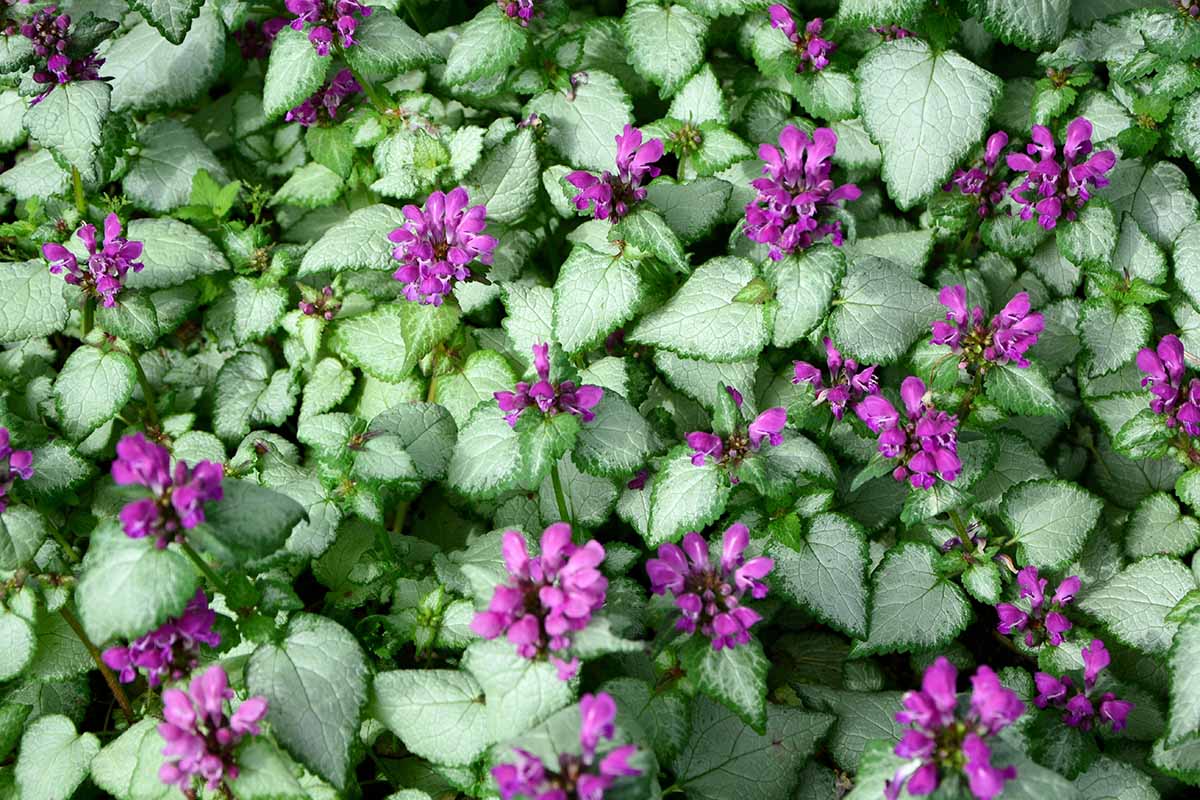
My favorite ones have gray leaves edged in green and are topped with petite but eye-catching reddish-purple blossoms. But of course, there are many options out there, including some with white flowers and spotted or solid leaves.
It’s beyond me why these plants are called deadnettles since I don’t think they look much at all like stinging nettle, but maybe that’s just me!
These mint relatives, which absolutely won’t sting you (that’s where the “dead” part of the common name comes from), are edible on top of being beautiful, and will bring some attractive foliage to the garden if it’s feeling a bit flower-heavy.
Just be aware that deadnettle can become a bit overly enthusiastic in its spread and will stretch out far and wide in the right conditions in Zones 3 to 8. It’s even considered invasive in Vermont.
10. Delphinium
Darling delphiniums (Delphinium spp.) are reliable self-seeders in Zones 3 to 9, but they’re not invasive.
Rather than lopping off the flower spikes after those vibrant purple, blue, white, lilac, yellow, or red flowers fade, let the seeds spread themselves around. While delphiniums are short-lived perennials, a patch will keep returning year after year.
Don’t confuse them with larkspur, though. While they look similar, larkspur is an annual.
I think ‘Magic Fountains’ is a particularly beautiful D. elatum cultivar.
The full flowers are dramatically deep royal purple with a bright white center. Bring home the magic by grabbing a live plant in a #1 container from Nature Hills Nursery.
Read our guide to learn more about growing delphiniums.
11. Euphorbia
Plants in the Euphorbia genus run the gamut from noxious weeds to fuss-free ornamentals like gopher plants (E. rigida) and flowering spurge (E. martinii).
While you’re welcome to plant the weedy kind if that’s your thing and it’s legal in your area, we’re talking about the ornamental types here.
Once they’re in your garden bed, Euphorbia species need little maintenance and will happily self-seed in Zones 4 and up, depending on the species.
E. lactea ‘Crested Cactus’ is a unique and fascinating option.
The bottom half of the plant is a cactus-like succulent rootstock with a coral-like, fan-shaped succulent grafted on top.
Plant one, or several, in the garden and wait for the comments to come rolling in.
Nature Hills Nursery carries this alien-like euphorbia.
Read more about the euphorbia genus here.
12. False Indigo
Beautiful false indigo (Baptisia australis) is instantly recognizable as the clusters of deep blue flower spikes you might see swaying in the wind of the prairie.
It’s just as elegant tamed and planted in the garden, whether you use it in a group for impact or to fill in a wildflower garden. And it’s hardy enough to grow pretty much anywhere from Zone 3 to 11.
The word “false” in the name separates this North American native from “true” indigo (Indigofera tinctoria), but it can also be used to make blue dye.
I can’t imagine why you wouldn’t want this beauty adding color to your garden. Do you agree? Snag packets of 50 seeds at Earthbeat Seeds.
13. Forget-Me-Not
I triple-dog dare you not to be happy when you’re holding a posy of forget-me-nots (Myosotis sylvatica).
The blue (or pink, or white) blossoms with their cheerful yellow centers add joyous color to the landscape for months and months.
When they’re done, they set to work seeding themselves so they can repeat the performance next year.
Just don’t forget that they’re considered invasive in some areas.
Do your research before planting and consider a self-seeding native such as alpine forget-me-nots (M. asiatica syn. M. alpestris) instead. They’re a bit more petite but every bit as colorful.
Both species grow in Zones 3 to 8, and both will go dormant in the heat of the summer. Don’t worry, they’ll return.
Don’t forget to pick up a packet, ounce, quarter-pound, or pound of seeds at Eden Brothers.
Our guide has more information about how to grow forget-me-nots.
14. Foxglove
Common foxglove (Digitalis purpurea) is a classic choice for the cottage garden.
In Britain, these plants were considered home to the fairies, and woe be to anyone who plucked the flowers and disturbed their home.
You can find flowers in white, cream, pink, purple, lavender, and yellow, most with speckles and flecks of contrasting colors, all happily growing in Zones 4 to 9 where they’re considered biennials.
In the Pacific Northwest and other temperate climates, some foxgloves – such as D. parviflora, D. lutea, D. grandiflora, and D. ferruginea – are short-lived perennials. Outside of that range, these flowers are grown as annuals.
Most bloom and produce seeds that sow themselves around the garden in their second year. Some hybrids will bloom in the first year, though. If you have a partially shady spot that could use some tall color, this is a killer option.
Speaking of killers, don’t eat them. They’re highly toxic.
‘Rose Shades’ is a lovely pick with tall spikes of rosy white and pink flowers. Burpee has bundles of four plants available to get you started.
Check out our guide to growing foxglove here.
15. Gladiolus
Sword-shaped leaves with tall spikes of vibrant blossoms are the hallmarks of gorgeous gladioli (Gladiolus spp.). In fact, “gladius” means sword in Latin.
They’re perfect for cut flower arrangements, but if you want to let them seed themselves throughout the garden, you just need to leave a few spikes in place after the blossoms fade.
In Zones 8 to 10, they’ll reliably return. But even in Zone 7, if you add an inch-thick layer of mulch to the garden after the seeds drop, they’ll be back the next year.
Hardy gladiolus, on the other hand, can handle climates as cold as that of Zone 3.
Cultivars such as G. ramosus ‘Volcano,’ G. nanus ‘Galaxian,’ and G. nanus ‘Atom’ are hardy, and most others that are will call it out in their name or plant tag description.
You can find a mix of hardy gladiolus in pinks, oranges, and whites available in packages of 20, 40, or 100 bulbs available from Eden Brothers.
Learn more about growing gladiolus here.
16. Hollyhock
It’s pretty hard to imagine a cottage garden without a few tall stalks of sweet hollyhocks (Alcea rosea).
Hummingbirds, bees, and butterflies love them, and we love them, too. They’re edible, can be used to make dyes, and who didn’t turn the flowers into fairy dolls when they were young?
Hollyhocks grow in Zones 3 to 9 as biennials or short-lived perennials. But if you neglect your deadheading chores, they’ll come back year after year.
I bought a house with a decidedly abandoned yard, and once we mowed the lawn, we discovered heaps of hollyhocks that started poking their heads up out of the edges of the lawn area.
Believe me when I say that while they may look delicate, they’re pretty tough.
While the singles are perfectly magical, the double flowers are hard to compete with. Snag a packet, ounce, or quarter-pound of seeds in a mix of hues at Eden Brothers.
Check out our guide to learn more about growing hollyhocks.
17. Hosta
Hostas are one of the most popular garden plants in North America. We can’t get enough of our plantain lilies because they fill shady areas that are difficult to liven up.
Some hybrids are sterile, without viable seed, but others will happily spread themselves around, assuming you live in Zones 3 to 9.
Much of the time, the new plants won’t look like the parents. But that’s all part of the fun, right?
Don’t snip off the flower stalks after they fade. Leave them in place to do their thing naturally, or wait for the stalks to form seed heads.
Then, rub the seed heads between your fingers. If the head is dry and opens readily, the seeds inside are ready to be planted.
‘Francee’ will grow true from seed, which is excellent, because the green leaves trimmed in white are something you’ll want to keep around.
Snag a live plant in a gallon-size container at Fast Growing Trees.
Learn more about growing hostas in our guide.
18. Lady’s Mantle
Alchemilla mollis is one of those adaptable, tough, but attractive plants that can fill in spaces in the garden where you’re sick of fighting to keep things alive.
However, that tough nature and its aggressive seeding habit can also make lady’s mantle a bit too enthusiastic in some environments.
If you’re willing to make the effort to keep it in check and you live Zones 3 to 8, add the velvety, serrated leaves and sprays of chartreuse flowers to your garden for some easygoing texture.
Visit our friends at Nature Hills Nursery to bring home this pretty lady as a live plant in a #1 container.
Learn all about how to grow lady’s mantle in our guide.
19. Lupine
One of the first flowers that I planted when I moved from a hot climate to a cooler one was the lupine (Lupinus spp.).
They’re just so whimsical and eye-catching, but they’re fairly particular about where they’ll grow.
In some areas, people grow them as annuals or half-hardy perennials. But in the right climate, they’ll self-seed without any effort. You can find species, hybrids, and cultivars that will thrive everywhere from Zone 4 to 9.
For the best performance, most US gardeners will be better off with the North American natives L. polyphyllus or L. perennis, or one of their hybrids.
I totally get why lupines are experiencing newfound popularity these days.
If you’re on the lupine train, grab some live wild lupine plants at Nature Hills Nursery.
They carry a three-pack of two-inch pots or #1 containers.
20. Marigold
Not all marigolds are perennials, but some are. Mexican or bush (Tagetes lemmoni) marigolds are perennials, while all the others we typically grow in our gardens are annuals.
Regardless, they’ll all toss out seeds and come back every season.
Bush marigolds aren’t like the ones you grow as annuals. They’re huge, reaching up to six feet tall and sometimes even taller, and they’re evergreen in Zones 8 to 11.
After the flowers are done blooming, they’ll go to seed, and those seeds will start new plants if you let them.

If you’d like to give growing this shrub a go, pick up a packet of 50 seeds at Amazon.
Learn more about growing marigolds in our guide.
21. Morning Glory
In Zones 9 to 11, some species of morning glory (Ipomoea spp.) are perennials, though many people in Zones 8 and down grow them as annuals.
Blue dawn flower (I. indica), Mexican morning glory (I. tricolor), heavenly blue (I. violacea), and moonflower (I. alba) are all tender perennials.
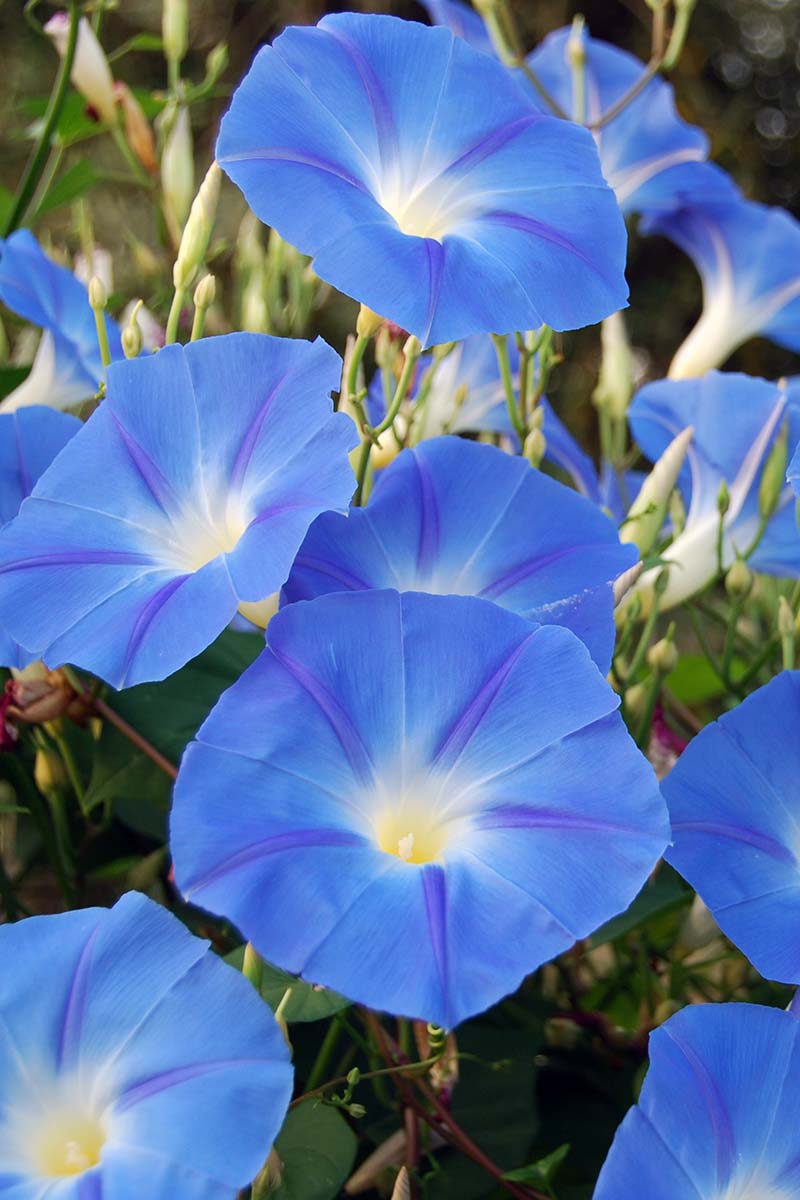
Just remember that some morning glories are considered invasive, so check with your local planting regulations.
These enchanting vines are covered in brilliant blossoms that stretch open with the sunrise and close up tight in the afternoon heat.
They also grow quickly, up to 10 feet per season. When they’re done blooming, green seed pods form. Once the pods turn brown, they will open, and the goodies inside will drop to the ground, starting new vines.
The annual types do the same thing, which is why many people believe all morning glories are perennials.
By the way, if you’re interested in saving your morning glory seeds, we have a guide that can walk you through the process.
‘Grandpa Ott’s’ is a dramatic option all dressed up in dark purple petals. Packets of seeds can be had at Botanical Interests.
Learn more about morning glories in our growing guide.
22. Nasturtium
Nasturtiums (Tropaeolum majus) are perennials in Zones 9 and up, but they self-seed so reliably that many people just assume they’re perennials in colder regions as well, despite the fact that the plant is actually dying each year.
That’s part of their charm as well as their downfall, because they can be a bit aggressive in the right conditions.
My solution to keeping them in check is to eat the papery blossoms as they appear so they don’t go to seed and turn my garden into a carpet of nasturtium.
But at the end of the year, I let a few go to seed so I don’t have to buy new ones next year.
To get you started, Burpee carries packets of 50 or 125 ‘Alaska’ seeds in mixed colors. ‘Alaska’ has variegated foliage, so it’s beautiful even when it isn’t in bloom.
Learn how to grow nasturtiums in our guide.
23. Pampas Grass
Pampas grass (Cortaderia selloana) is having a moment. It seems everyone wants to get their hands on the grass with the massive, fluffy heads to fill vases and pots in their homes.
Those heads are undeniably pretty, but do you know what else they are? Packed full of hundreds of seeds, just waiting to be carried away to the soil so they can start new plants.
I don’t know if I prefer the white or the pink version more. Maybe both?
You can nab yourself a packet of white plumed grass seed at Eden Brothers and then pick up seeds to grow your own pink poms (C. selloana ‘Rosea’) at Nature Hills Nursery.
Just imagine how gorgeous your Zone 7 to 9 garden is going to look.
Find tips on growing pampas grass here.
24. Primrose
Lots of us grow primroses (Primula spp.) as annuals, but they’re short-lived perennials that will reseed themselves year after year.
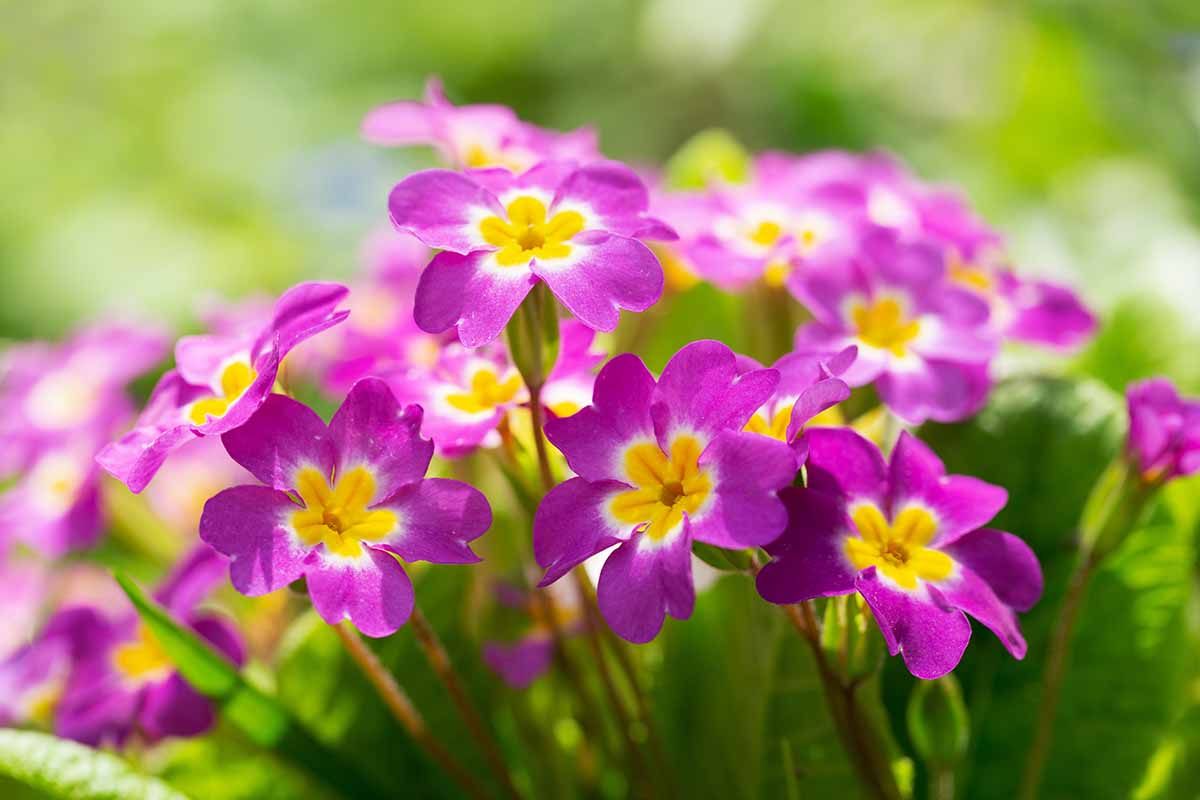
The cheery flowers are highly fragrant, and the color is undeniably eye-catching. You can also eat them!
Just be sure to leave a few on the plant so they can develop seeds and spread away.
25. Rose Campion
Dusty miller, rose campion, bloody William, mullein-pink… whatever you call Silene coronaria (syn. Lychnis coronaria), it’s a classic garden choice for Zones 3 to 10.
Thanks to its tolerance for a wide range of soil types, sun exposure, and soil moisture, it has earned a place in many a mixed bed, border, or container.
‘Orange Gnome’ has bright orange blossoms and purple-bronze leaves. Bring the bees, butterflies, and hummingbirds your way by picking up a plant at Nature Hills Nursery.
26. Sedge
Sedges (Carex spp.) are one of those plants you see all over the place, but you rarely recognize what it is. Most people call it “grass,” and though they’re related, grasses are in a different family.
These beautiful plants are a bit more humble than the flowers we fill our gardens with, but they’re incomparable for adding texture. Plus, the seed heads are an attractive focal point before they take a leap into your garden bed.
The real challenge with growing these adaptable plants is choosing one. There are a lot of great ones out there, for Zones ranging from 3 to 10, depending on the species.
‘Ice Dance,’ for instance, can fill a damp, shady spot with its dark green leaves edged in white. Nature Hills Nursery sells a live plant in a #1 container if that sounds good.
‘Orange New Zealand,’ (C. testacea) offers fall color, copper-shouldered oval (C. bicknellii) has bright yellow seed heads, and ‘Evergold’ (C. oshimensis) has creamy yellow and green foliage that resembles little fountains of gold and green.
Our guide to growing sedge has cultivation instructions.
27. Solomon’s Seal
Solomon’s seal (Polygonatum spp.) is a common name that covers a huge group of plants, from wild types that are foraged to eat and make beads out of, to ornamental types that have been cultivated for modern gardens. They grow all over the place in Zones 3 to 9.
The clusters of bell-shaped flowers and bird-attracting purple-black fruits are the frosting on top of the elegant, oval-shaped leaves. Some even have variegated foliage.
The challenge is to get the seeds into the ground in your garden before the birds nab them and drop them somewhere else. Your neighbors might appreciate the gift, but we want some of those seeds, too.
To ensure they take root where you want them to, pluck the seeds off when they’re plump and juicy and stick them in the soil about half an inch deep.
For extra visual interest, pick up a variegated option. ‘Variegatum’ is available at Nature Hills Nursery.
28. Sweet Alyssum
Sweet alyssum (Lobularia maritima) forms a fragrant carpet of color wherever you (or the plant) sprinkle the seeds in Zones 5 to 9.
Each fall before the first heavy frost, my grandma and I would grab her sweet alyssums by the base and pull them out of the ground.
Before we tossed them into the yard waste bin, we would give them a little shake to release all the seeds back into the garden so she could enjoy another year of their pretty blossoms.
Many cultivars are white, but ‘Royal Carpet’ offers up rich purples fit for a queen. If you want to roll out the royal carpet, pick up 2,500 seeds at Burpee.
Learn more about sweet alyssum and how to grow it in our guide.
29. Viola
Cold-hardy, colorful, and edible, violas (Viola spp.) give you endless beauty from early spring until after the frost arrives.
They’re reliable reseeders that will return every year, slowly creeping throughout the garden in Zones 3 to 9.
‘Psychedelic Spring’ will send you on a trip through fields of pink, maroon, violet, and yellow, with white edges that outline the shape of the petals.
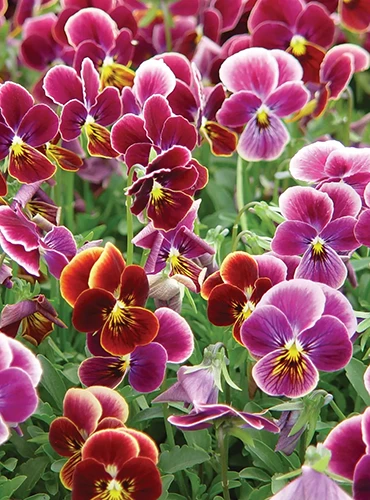
Make 35 seeds yours by heading to Burpee.
Find our guide to growing violas here.
Plant Once and Watch the Show
Gardening is always rewarding, whether you’re cleaning out an overgrown bed or reveling in the glorious rose display that you nurtured.
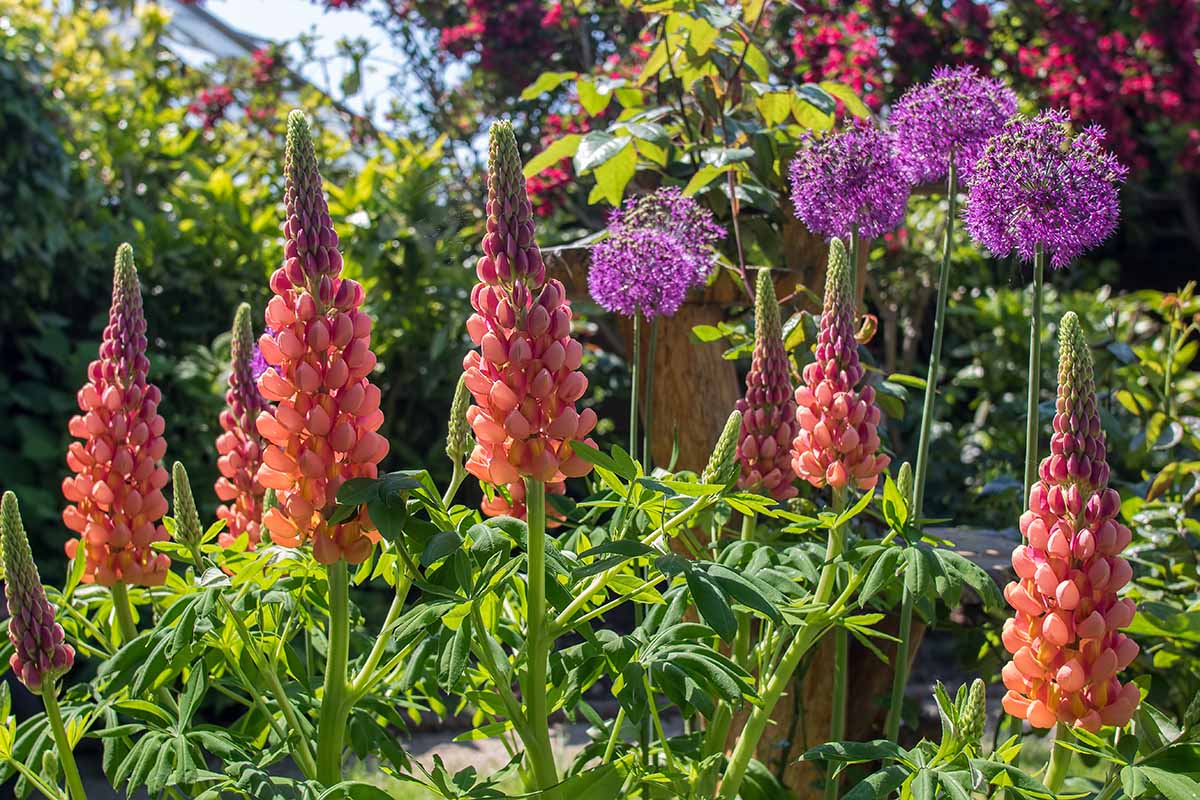
But there’s something extra fulfilling about watching a big bed of flowers showing off in the summer that you didn’t have to plant or pay for that year.
It almost feels like you cheated the system a little, right?
Which of these marvels do you plan to add to your garden? Did we miss a favorite reseeding perennial of yours? Let us know in the comments.
To continue on your perennial growing journey, we have a few guides that might be of interest:

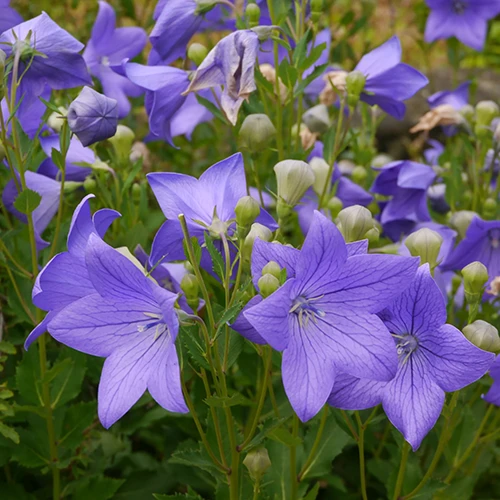

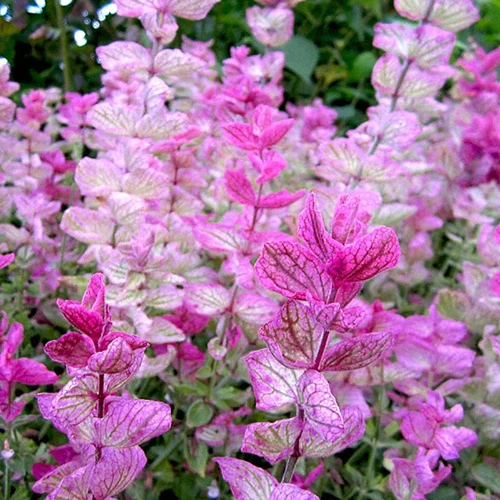
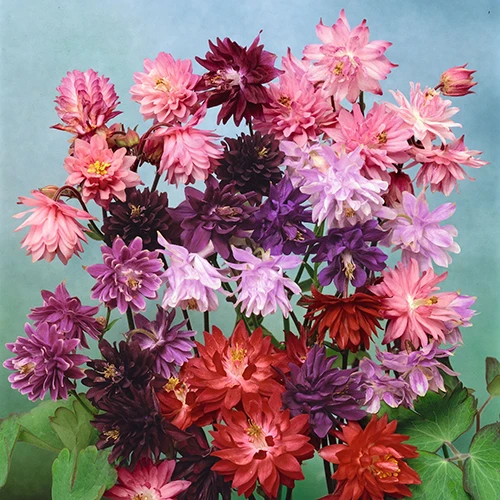

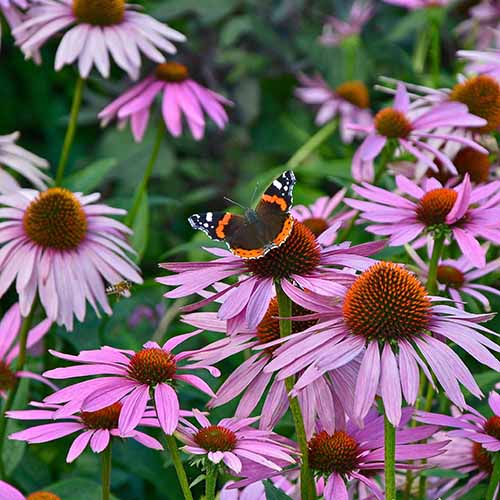
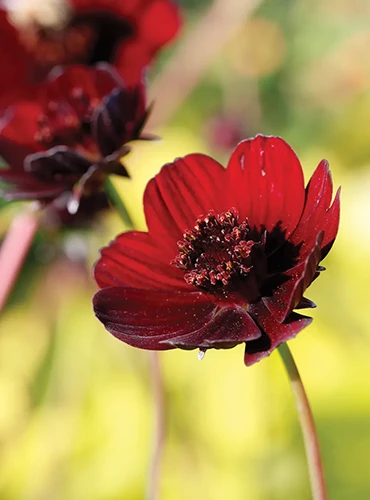

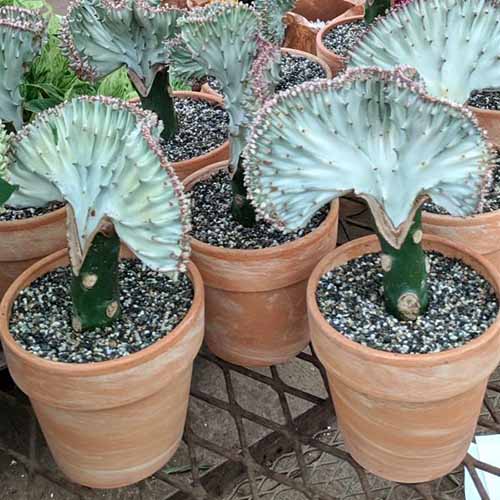
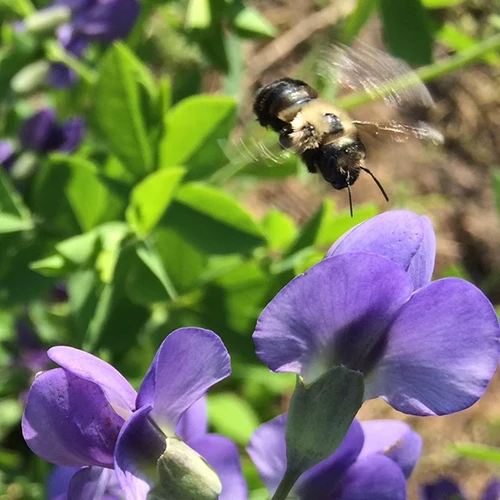



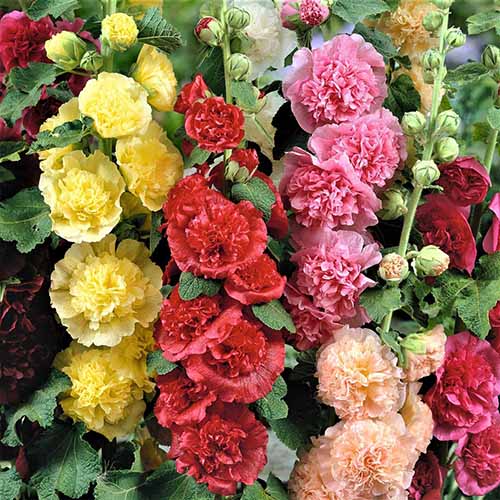
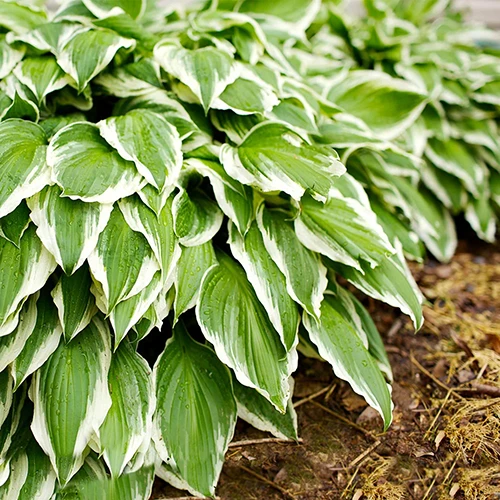

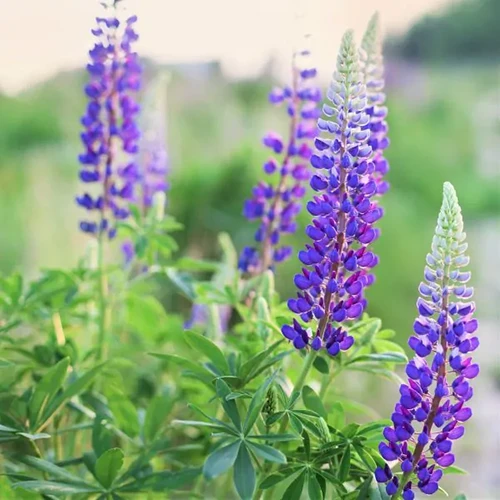
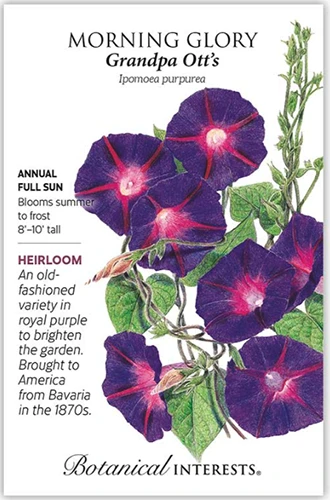

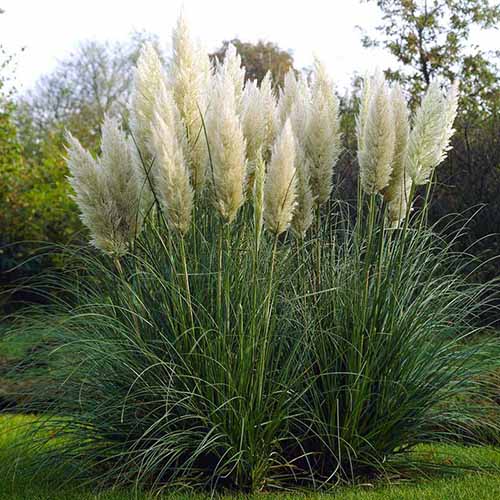
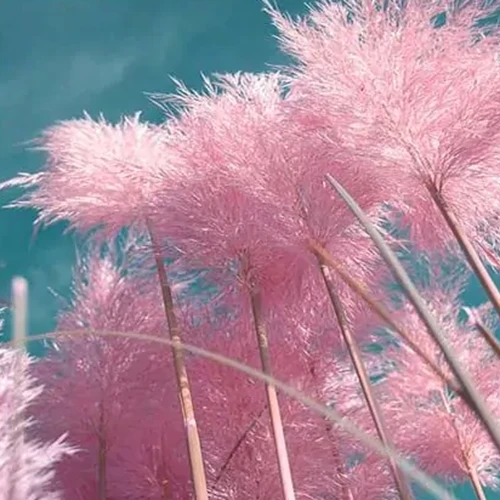
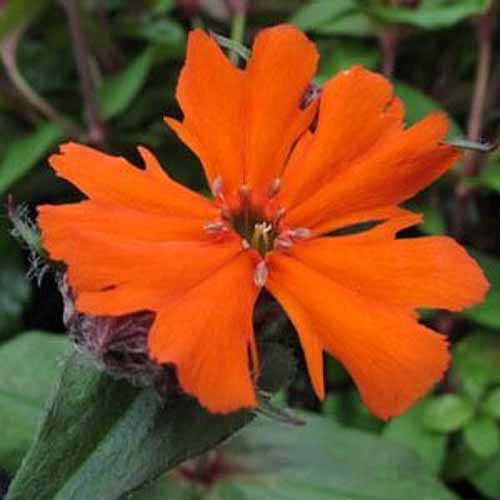
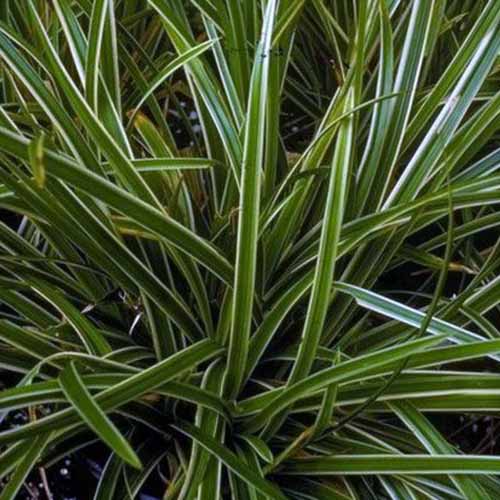
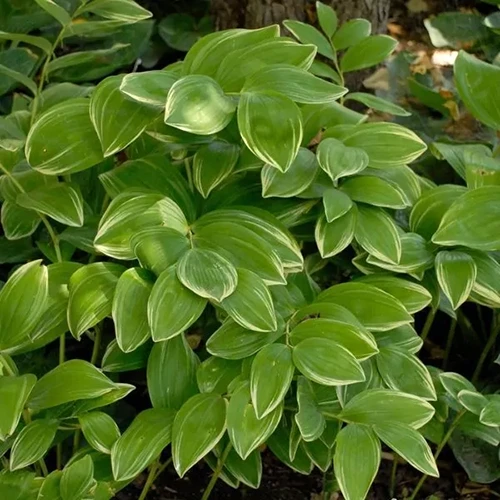
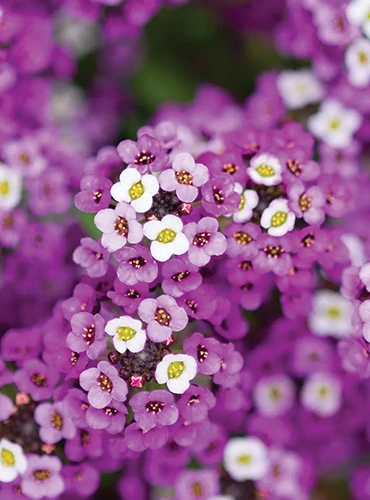


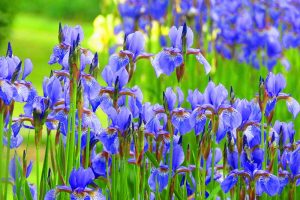
Your choices are good. I would add 2 of my favorites, calendula and verbena bonariensis. They do require thinning so it’s not quite as easy as your choices but they bloom all year and birds feed off the seeds in the winter
Hello, do your calendula and verbena bonaerensis come back? Thanks for your answer
They self seed but after a mild winter the verbena is a tender perennial and will come back in southeastern ontario. Can’t speak for other areas. Guara is another favorite but must be thinned. Also a tender perennial and often comes back.
Very informative
Learned so much in your Self-seeding Perennial article.
Please subscribe me
Thanks so much for reading, Carol! You can sign up to receive push notifications on your mobile device whenever we publish new content via the popup window on our home page. Please feel free to follow us on social media as well.
Thank you
You’re welcome! Thanks for reading, Paul!
What are these flowers called?
Sorry your photo didn’t upload properly, Brenda. I can see that you’re referring to the last image in our article. These are ‘Terracotta’ lupines in the foreground, and purple alliums in the background.
Thanks so much for the information! Really useful!
You’re welcome, Lidia!
I really like this site. Wish I had seen it earlier. Thanks
Thank you for the kind words John!
What is the flower in your last picture?
This is a lupine cultivar known as ‘Terracotta’ up front, with purple alliums at the back.
Calendula and verbena bonisaris are also fabulous self seeders. Southeastern ontario.